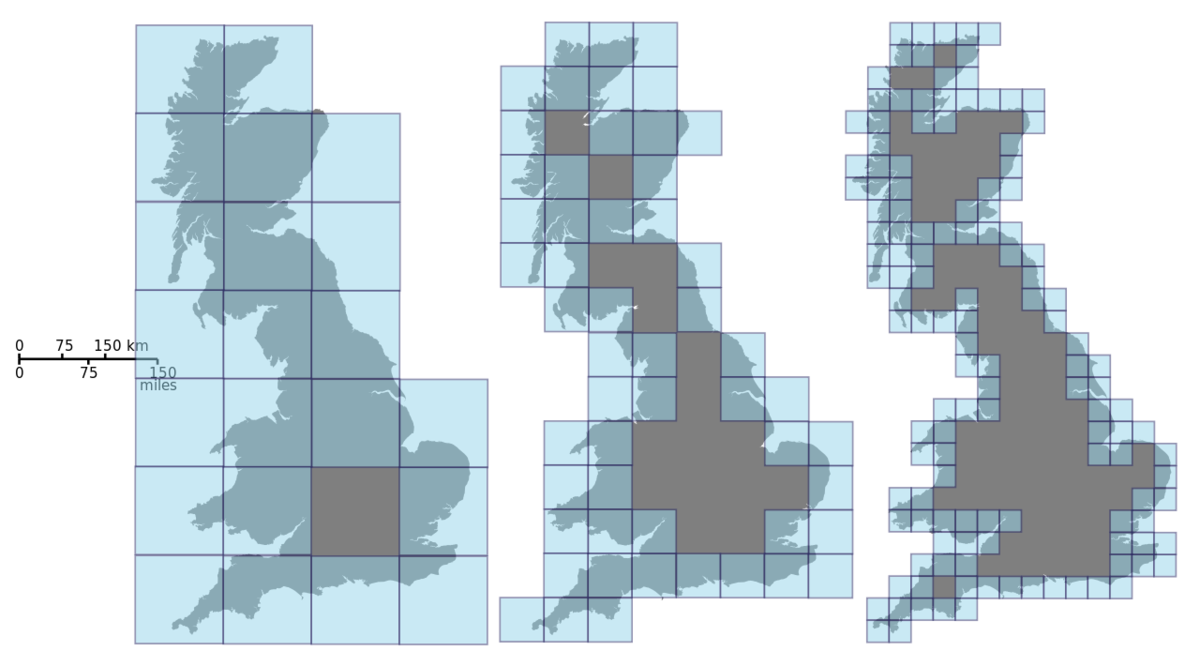Minkowski Dimension
In the study of fractals, Minkowski dimension (a.k.a. box-counting dimension) is a notion of dimension for fractals, measuring how complexity of detail changes with the scale at which one views the fractal. Very roughly, the larger a fractal's Minkowski dimension, the more self-similar the fractal is, in the sense that the fractal contains many constricted copies of itself.
 This picture estimates the Minkowski dimension of Great Britain by covering it with boxes of smaller and smaller size.[1]
This picture estimates the Minkowski dimension of Great Britain by covering it with boxes of smaller and smaller size.[1]
Motivation and Definition
Consider a square \(I^2\) of side length 1. For each \(k\in \mathbb{N}\), the square may be covered by smaller squares of side length \(s = \frac1k\). Each of these squares is a scaled copy of \(I^2\) \((\)where the smaller squares are scaled down by a factor of \(k),\) and it takes \(k^2 = \frac1{s^2}\) smaller squares to cover all of \(I^2\). Similarly, if one were to cover the cube \(I^3\) of side length 1 with cubes of side length \(s = \frac1k\), it would take \(k^3 = \frac1{s^3}\) to do so. This suggests that the exponent of this "box-counting function," which takes in side length and returns how many such boxes one would need to cover the whole figure, can be thought of as a sort of dimensional measurement. For instance, the dimension of the cube \(I^3\) (to which any reasonable notion of dimension should assign the number 3) can be retrieved as \[\frac{\log\left(\frac1{s^3}\right)}{\log\left(\frac1s\right)} = \frac{-3 \log(s)}{-\log(s)} = 3.\] One can formalize this observation as follows: Let \(X\subset \mathbb{R}^n\) be the object whose fractal dimension is to be measured. For each \(\epsilon >0\), let \(f(\epsilon)\) denote the minimum number of non-overlapping \(n\)-dimensional boxes of side length \(\epsilon\) necessary to cover \(X\). By \(n\)-dimensional box of side length \(\epsilon\), we mean a translated copy of the \(n\)-fold product of intervals \([0,\epsilon]^n \subset \mathbb{R}^n\).
The upper Minkowski dimension of \(X\) is \[\overline{\dim}_{\text{box}}(X) := \limsup_{\epsilon \to 0} \frac{ \log\big(f(\epsilon)\big)}{\log\left(\frac1{\epsilon}\right)}\] and the lower Minkowski dimension of \(X\) is \[\underline{\dim}_{\text{box}}(X) := \liminf_{\epsilon \to 0} \frac{ \log\big(f(\epsilon)\big)}{\log\left(\frac1{\epsilon}\right)}.\] If \(\overline{\dim}_{\text{box}}(X) = \underline{\dim}_{\text{box}}(X) \), then the common value is denoted \(\dim_{\text{box}}(X)\) and called the Minkowski dimension of \(X\).
Examples/Computations
The following computations will be rough and some steps will remain unjustified; to give careful proofs would require more details than are instructive.
Let \(X = \{p_1, \ldots, p_d\} \subset \mathbb{R}^n\) be a finite set of points. Compute the Minkowski dimension of \(X\).
We may cover \(X\) by simply placing a box on each point, so \(f(\epsilon) = d\) for all \(\epsilon > 0\). Thus, the Minkowski dimension of \(X\) is \[\lim_{\epsilon \to 0} \frac{\log(d)}{\log\left(\frac1\epsilon\right)} = 0.\] This is consistent with our intuition that points (and finite sets of them) should have zero dimension. \(_\square\)
Let \(X = \left\{0, 1, \frac{1}{2}, \frac{1}{3}, \frac{1}{4}, \ldots \right\}\). Compute the upper Minkowski dimension of \(X\).
Write \(X = A \cup B\), where \(A =\left \{1, \frac{1}{2}, \ldots, \frac{1}{n} \right\}\) and \(B = \left \{\frac{1}{n+1}, \frac{1}{n+2}, \ldots\right\}\). For \(\epsilon < \frac{1}{n} - \frac{1}{n+1} < \frac{1}{n^2}\), we can cover \(A\) with \(n\) intervals of length \(\epsilon\), one centered at each point in \(A\). And, we can cover \(B\) with approximately \(n\) intervals of length \(\epsilon\), since all elements of \(B\) are contained in \(\left[0,\frac1n\right]\). Thus, \(f(\epsilon) \approx 2n \approx \frac2{\sqrt{\epsilon}}\). It follows that \[\overline{\dim}_{\text{box}}(X) = \limsup_{\epsilon \to 0} \frac{\log\left(\frac2{\sqrt{\epsilon}}\right)}{\log\left(\frac1\epsilon\right)} = \frac{1}{2}.\ _\square\]
Let \(X = \mathbb{Q} \cap [0,1]\), the set of rational numbers in the interval \([0,1]\). What is the Minkowski dimension of \(X?\)
Let \(X \subset \mathbb{R}\) be the middle-thirds Cantor set \(\mathcal{C}\). Compute the upper Minkowski dimension of \(X\).
Note that \(\mathcal{C}\) is the union of two copies of itself scaled down by a factor of \(\frac13\). Thus, if \(\mathcal{C}\) can be covered by \(f(\epsilon)\) intervals of length \(\epsilon\), then \(\mathcal{C}\) can be covered by \(2f(\epsilon)\) intervals of length \(\frac{\epsilon}3\), and hence \(f\left(\frac{\epsilon}3\right) \approx 2f(\epsilon)\).
Certainly, \(f(1) = 1\), so \(f\left(\frac1{3^n}\right) \approx 2^n\). Accordingly, we have \[ \overline{\dim}_{\text{box}}(X) = \lim_{n\to\infty} \frac{\log\Big(f\left(\frac1{3^n}\right)\Big)}{\log(3^n)} = \frac{\log(2)}{\log(3)}.\ _\square\]
Let \(X\) denote the Sierpinski triangle as defined in fractals. What is the upper Minkowski dimension of \(X?\)

References
- Prokofiev, . Estimating the box-counting dimension of the coast of Great Britain. Retrieved September 7, 2016, from https://en.wikipedia.org/wiki/Minkowski%E2%80%93Bouligand_dimension#/media/File:Great_Britain_Box.svg